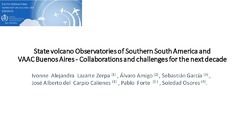Mostrar el registro sencillo del ítem
State volcano Observatories of Southern South America and VAAC Buenos Aires Collaborations and challenges for the next decade
| dc.contributor.author | Lazarte Zerpa, Ivonne Alejandra | |
| dc.contributor.author | Amigo, Álvaro | |
| dc.contributor.author | García, Sebastián | |
| dc.contributor.author | del Carpio Calienes, José Alberto | |
| dc.contributor.author | Forte, Pablo | |
| dc.contributor.author | Osores, María Soledad | |
| dc.date.accessioned | 2023-12-28T17:28:15Z | |
| dc.date.available | 2023-12-28T17:28:15Z | |
| dc.date.issued | 2023-12 | |
| dc.identifier.uri | http://hdl.handle.net/20.500.12160/2653 | |
| dc.description | Fil: Osores, María Soledad. Servicio Meteorológico Nacional; Argentina. | |
| dc.description | Fil: del Carpio Calienes, José Alberto. Instituto Geofísico del Perú; Perú. | |
| dc.description | Fil: Lazarte Zerpa, Ivonne Alejandra. Instituto Geofísico del Perú; Perú. | |
| dc.description | Fil: Amigo, Álvaronne Alejandra. Servicio Nacional De Geología y Minería; Chile. | |
| dc.description | Fil: García, Sebastián. Observatorio Argentino de Vigilancia Volcánica. Servicio Geológico y Minero Argentino; Argentina. | |
| dc.description | Fil: Forte, Pablo. Observatorio Argentino de Vigilancia Volcánica. Servicio Geológico y Minero Argentino; Argentina. | |
| dc.description.abstract | Volcanic ash poses a significant hazard to aviation, as demonstrated by several encounters between ash clouds and aircraft over the last decades. This represents a concern to aviation authorities from all around the globe but especially to those from southern South American countries, where explosive volcanic activity in the Andes range recurrently injects variable amounts of volcanic ash into their airspace. In addition, once in the atmosphere, this pyroclastic material has the potential to be transported hundreds to thousands of kilometers away from the source, turning this into a transboundary issue. For this reason, the Argentinian, Chilean, and Peruvian volcano observatories have been working in the last years to contribute to civil aviation safety. In the framework of the International Aviation Volcano Watch system of the International Civil Aviation Organization (ICAO), these institutions has been sharing information with VAAC Buenos Aires about significant pre-eruption volcanic activity, volcanic eruption onsets and volcanic ash cloud being formed over volcanoes under their surveillance. The information exchange includes also the presence of ash clouds due to aeolian resuspension events. During the last years, the collaboration between these volcano observatories and VAAC Buenos Aires has strengthened by improving communication, sharing information through reports and making an annual update of the contact list. The new status and requirements for VONA production and transmission will pose new challenges to the southern South American volcano observatories. In this presentation, we will review the current state of the collaboration between volcano observatories and VAAC in this region and share some reflections on the challenges ahead the changes in VONA production. | en |
| dc.format | application/pdf | |
| dc.language.iso | eng | es |
| dc.publisher | World Meteorological Organization | es |
| dc.rights | info:eu-repo/semantics/openAccess | es |
| dc.rights | http://creativecommons.org/licenses/by/2.5/ar/ | es |
| dc.rights | info:eu-repo/semantics/openAccess | es |
| dc.subject | STATE VOLCANO OBSERVATORIES | es |
| dc.subject | SOUTHERN SOUTH AMERICA | es |
| dc.subject | VAAC BUENOS AIRES | es |
| dc.subject | PERÚ | es |
| dc.subject | CHILE | es |
| dc.subject | ARGENTINA | es |
| dc.title | State volcano Observatories of Southern South America and VAAC Buenos Aires Collaborations and challenges for the next decade | es |
| dc.type | Diapositiva | es |
